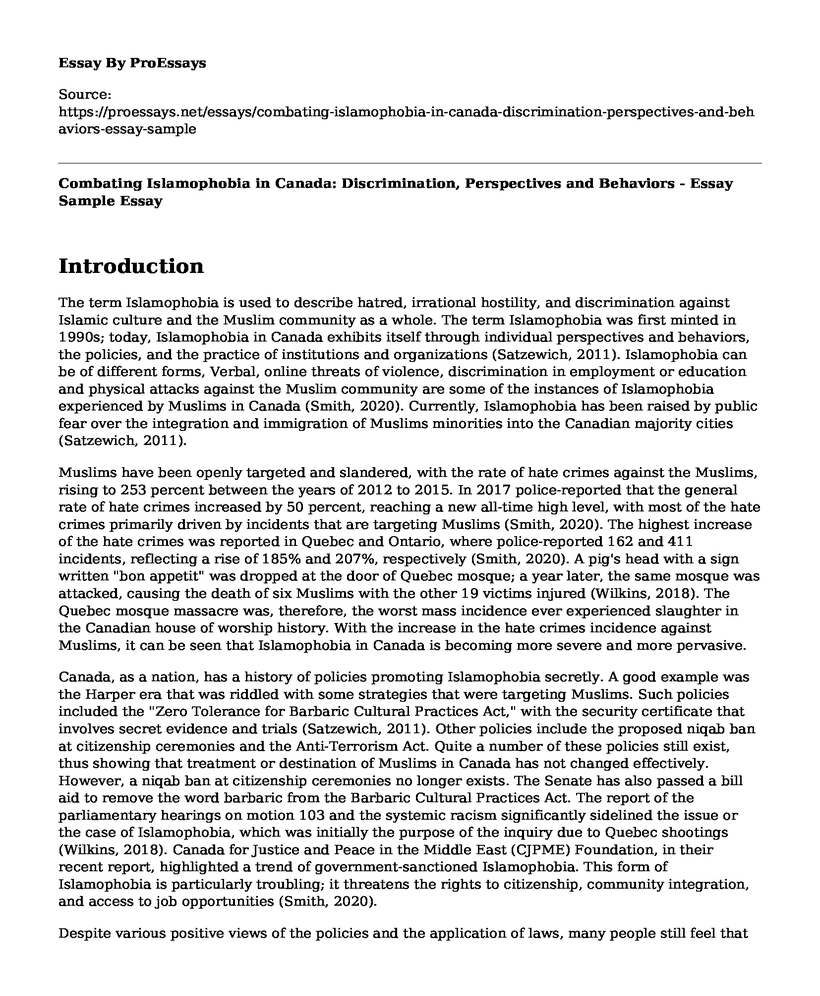Introduction
The term Islamophobia is used to describe hatred, irrational hostility, and discrimination against Islamic culture and the Muslim community as a whole. The term Islamophobia was first minted in 1990s; today, Islamophobia in Canada exhibits itself through individual perspectives and behaviors, the policies, and the practice of institutions and organizations (Satzewich, 2011). Islamophobia can be of different forms, Verbal, online threats of violence, discrimination in employment or education and physical attacks against the Muslim community are some of the instances of Islamophobia experienced by Muslims in Canada (Smith, 2020). Currently, Islamophobia has been raised by public fear over the integration and immigration of Muslims minorities into the Canadian majority cities (Satzewich, 2011).
Muslims have been openly targeted and slandered, with the rate of hate crimes against the Muslims, rising to 253 percent between the years of 2012 to 2015. In 2017 police-reported that the general rate of hate crimes increased by 50 percent, reaching a new all-time high level, with most of the hate crimes primarily driven by incidents that are targeting Muslims (Smith, 2020). The highest increase of the hate crimes was reported in Quebec and Ontario, where police-reported 162 and 411 incidents, reflecting a rise of 185% and 207%, respectively (Smith, 2020). A pig's head with a sign written "bon appetit" was dropped at the door of Quebec mosque; a year later, the same mosque was attacked, causing the death of six Muslims with the other 19 victims injured (Wilkins, 2018). The Quebec mosque massacre was, therefore, the worst mass incidence ever experienced slaughter in the Canadian house of worship history. With the increase in the hate crimes incidence against Muslims, it can be seen that Islamophobia in Canada is becoming more severe and more pervasive.
Canada, as a nation, has a history of policies promoting Islamophobia secretly. A good example was the Harper era that was riddled with some strategies that were targeting Muslims. Such policies included the "Zero Tolerance for Barbaric Cultural Practices Act," with the security certificate that involves secret evidence and trials (Satzewich, 2011). Other policies include the proposed niqab ban at citizenship ceremonies and the Anti-Terrorism Act. Quite a number of these policies still exist, thus showing that treatment or destination of Muslims in Canada has not changed effectively. However, a niqab ban at citizenship ceremonies no longer exists. The Senate has also passed a bill aid to remove the word barbaric from the Barbaric Cultural Practices Act. The report of the parliamentary hearings on motion 103 and the systemic racism significantly sidelined the issue or the case of Islamophobia, which was initially the purpose of the inquiry due to Quebec shootings (Wilkins, 2018). Canada for Justice and Peace in the Middle East (CJPME) Foundation, in their recent report, highlighted a trend of government-sanctioned Islamophobia. This form of Islamophobia is particularly troubling; it threatens the rights to citizenship, community integration, and access to job opportunities (Smith, 2020).
Despite various positive views of the policies and the application of laws, many people still feel that there is a widespread negative social perception and attitudes about Muslims and Islam as a whole. The extent and variety of Islamophobia incidences committed against Canadian Muslims remain underreported or under-documented due to hesitation in the implementation of Anti- Muslims hate crime laws (Wilkins, 2018). Many speak about the predominance of a negative impression against Muslims due to their association with the terrorist groups like the Hezb-e Islami Gulbuddin based in Canada, Alsaabab, and Al Qaeda (Smith, 2020). Generally, the discrimination of Muslims in Canada has not gotten better over the years.
The government should, therefore, make a concerted effort to reinforce the existing legal guarantees and the constitutional rights against discrimination based on religion and race. The Canadian government should implement sensitivity training for the public employees and state guidelines to all Canadian citizens. Such programs can enhance the relationship of the individual with the Muslim community.
References
Satzewich, V. (2011). Racism in Canada. Oxford University Press. Retrieved from https://global.oup.com/academic/product/racism-in-canada-9780195430660?cc=us&lang=en&
Smith, S. J. (2020). Challenging Islamophobia in Canada: non-Muslim social workers as allies with the Muslim community. Journal of Religion & Spirituality in Social Work: Social Thought, 39(1), 27-46. Retrieved from https://www.tandfonline.com/doi/abs/10.1080/15426432.2019.1651240
WilkinsLaflamme, S. (2018). Islamophobia in Canada: Measuring the realities of negative attitudes toward Muslims and religious discrimination. Canadian Review of Sociology/Revue canadienne de sociologie, 55(1), 86-110. Retrieved from https://onlinelibrary.wiley.com/doi/abs/10.1111/cars.12180
Cite this page
Combating Islamophobia in Canada: Discrimination, Perspectives and Behaviors - Essay Sample. (2023, Apr 21). Retrieved from https://proessays.net/essays/combating-islamophobia-in-canada-discrimination-perspectives-and-behaviors-essay-sample
If you are the original author of this essay and no longer wish to have it published on the ProEssays website, please click below to request its removal:
- Parents' Response to Child and Youth Gaming Essay
- Racism in the Jewish Community & Anti-Semitism in the Black Community: Can the Rift Be Healed?
- The Stigmas African Americans Face About Mental Health Annotated Bibliography
- Essay Example on Hijab: A Social Status & Compulsory Dress for Muslim Women
- Chinese Immigrants Create Refuge in Chinatown: New York's Ethnic-Based Community - Essay Sample
- Sex Offender Registration: Averting Sexual Violence or Recidivism - Report Example
- Paper Example on Facilitating Abortions in the World







